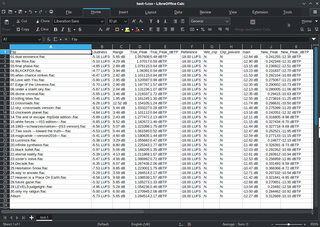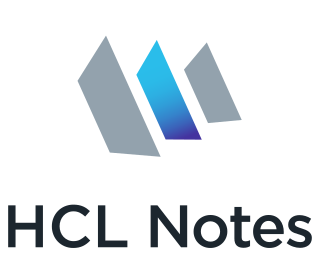
Microsoft Excel is a spreadsheet editor developed by Microsoft for Windows, macOS, Android, iOS and iPadOS. It features calculation or computation capabilities, graphing tools, pivot tables, and a macro programming language called Visual Basic for Applications (VBA). Excel forms part of the Microsoft 365 suite of software.

A spreadsheet is a computer application for computation, organization, analysis and storage of data in tabular form. Spreadsheets were developed as computerized analogs of paper accounting worksheets. The program operates on data entered in cells of a table. Each cell may contain either numeric or text data, or the results of formulas that automatically calculate and display a value based on the contents of other cells. The term spreadsheet may also refer to one such electronic document.

HCL Notes is a proprietary collaborative software platform for Unix, Windows, Linux and macOS, sold by HCLTech. The client application is called Notes while the server component is branded HCL Domino.
Lotus Symphony was an integrated software package for creating and editing text, spreadsheets, charts and other documents on the MS-DOS operating systems. It was released by Lotus Development as a follow-on to its popular spreadsheet program, Lotus 1-2-3, and was produced from 1984 to 1992. Lotus Jazz on the Apple Macintosh was a sibling product.
Lotus Software was an American software company based in Massachusetts; it was "offloaded" to India's HCL Technologies in 2018.
A stored procedure is a subroutine available to applications that access a relational database management system (RDBMS). Such procedures are stored in the database data dictionary.

The Microsoft Windows Script Host (WSH) is an automation technology for Microsoft Windows operating systems that provides scripting abilities comparable to batch files, but with a wider range of supported features. This tool was first provided on Windows 95 after Build 950a on the installation discs as an optional installation configurable and installable by means of the Control Panel, and then a standard component of Windows 98 and subsequent and Windows NT 4.0 Build 1381 and by means of Service Pack 4. The WSH is also a means of automation for Internet Explorer via the installed WSH engines from IE Version 3.0 onwards; at this time VBScript became means of automation for Microsoft Outlook 97. The WSH is also an optional install provided with a VBScript and JScript engine for Windows CE 3.0 and following and some third-party engines including Rexx and other forms of Basic are also available.
Transact-SQL (T-SQL) is Microsoft's and Sybase's proprietary extension to the SQL used to interact with relational databases. T-SQL expands on the SQL standard to include procedural programming, local variables, various support functions for string processing, date processing, mathematics, etc. and changes to the DELETE and UPDATE statements.
TK Solver is a mathematical modeling and problem solving software system based on a declarative, rule-based language, commercialized by Universal Technical Systems, Inc.
Automated planning and scheduling, sometimes denoted as simply AI planning, is a branch of artificial intelligence that concerns the realization of strategies or action sequences, typically for execution by intelligent agents, autonomous robots and unmanned vehicles. Unlike classical control and classification problems, the solutions are complex and must be discovered and optimized in multidimensional space. Planning is also related to decision theory.
In software engineering, inversion of control (IoC) is a design pattern in which custom-written portions of a computer program receive the flow of control from a generic framework. The term "inversion" is historical: a software architecture with this design "inverts" control as compared to procedural programming. In procedural programming, a program's custom code calls reusable libraries to take care of generic tasks, but with inversion of control, it is the framework that calls the custom code.
ARexx is an implementation of the Rexx language for the Amiga, written in 1987 by William S. Hawes, with a number of Amiga-specific features beyond standard REXX facilities. Like most REXX implementations, ARexx is an interpreted language. Programs written for ARexx are called "scripts", or "macros"; several programs offer the ability to run ARexx scripts in their main interface as macros.
OpenFormula is an open standard for exchanging recalculated formulae in spreadsheets. OpenFormula is included in version 1.2 of the OpenDocument standard. OpenFormula was initially proposed and drafted by David A. Wheeler.
MAPPER Systems, now known as Business Information Server, BIS, is a fourth-generation programming language originally from Sperry Univac. Now owned by Unisys Corporation. Mapper originated in the 1970s based on some work in the 1960s, It has been functionally enhanced and kept current. It was also given an extension named ICE - Internet Commerce Enabler.

Numbers is a spreadsheet application developed by Apple Inc. as part of the iWork productivity suite alongside Keynote and Pages. Numbers is available for iOS and macOS High Sierra or newer. Numbers 1.0 on Mac OS X was announced on August 7, 2007, making it the newest application in the iWork suite. The iPad version was released on January 27, 2010. The app was later updated to support iPhone and iPod Touch.
In computing science and informatics, nesting is where information is organized in layers, or where objects contain other similar objects. It almost always refers to self-similar or recursive structures in some sense.

Control tables are tables that control the control flow or play a major part in program control. There are no rigid rules about the structure or content of a control table—its qualifying attribute is its ability to direct control flow in some way through "execution" by a processor or interpreter. The design of such tables is sometimes referred to as table-driven design. In some cases, control tables can be specific implementations of finite-state-machine-based automata-based programming. If there are several hierarchical levels of control table they may behave in a manner equivalent to UML state machines
XPages is an IBM implementation of JavaServer Faces with a server side JavaScript runtime and the built-in NoSQL database IBM Domino. It allows data from IBM Notes and Relational Databases to be displayed to browser clients on all platforms.
The functional database model is used to support analytics applications such as financial planning and performance management. The functional database model, or the functional model for short, is different from but complementary to the relational model. The functional model is also distinct from other similarly named concepts, including the DAPLEX functional database model and functional language databases.
This glossary of computer science is a list of definitions of terms and concepts used in computer science, its sub-disciplines, and related fields, including terms relevant to software, data science, and computer programming.




